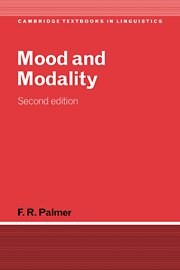Book contents
- Frontmatter
- Contents
- Preface
- Note on the text
- List of abbreviations
- 1 Introduction
- 2 Modal systems: Propositional modality
- 3 Modal systems: Event modality
- 4 Modal systems and modal verbs
- 5 Indicative and subjunctive
- 6 Realis and Irrealis
- 7 Subjunctive and irrealis
- 8 Past tense as modal
- References
- Language index
- General index
4 - Modal systems and modal verbs
Published online by Cambridge University Press: 05 June 2012
- Frontmatter
- Contents
- Preface
- Note on the text
- List of abbreviations
- 1 Introduction
- 2 Modal systems: Propositional modality
- 3 Modal systems: Event modality
- 4 Modal systems and modal verbs
- 5 Indicative and subjunctive
- 6 Realis and Irrealis
- 7 Subjunctive and irrealis
- 8 Past tense as modal
- References
- Language index
- General index
Summary
The modal systems described in the last two chapters share a number of features, not only in the systems themselves, but also, for many languages, in the use of modal verbs and the association with possibility and necessity. A detailed discussion of these has been left to this chapter in order to avoid too much repetition and cross-referencing. These issues hardly affect evidential, so that the discussion is almost entirely concerned with epistemic, deontic and dynamic modality.
Modal systems
Formal identity of different systems
Notionally, epistemic modality and deontic/dynamic modality might seem to have little in common. As suggested in 1.2.2, epistemic modality is concerned solely with the speaker's attitude to the truth value or factual status of the proposition (propositional modality), whereas deontic and dynamic modality refer to events that are not actualized, events that have not taken place but are merely potential (event modality). Yet in English (and many other languages) the same forms are used for both types. The following, for instance, can all be interpreted either epistemically or deontically:
He may come tomorrow
The book should be on the shelf
He must be in his office
Where the same verbs are used for the different types of modality, there are often slight differences in the forms, which will be summarized in 4.2.3. Such differences suggest that the types are grammatically as well as notion-ally different, but do not explain why the forms are basically the same.
Information
- Type
- Chapter
- Information
- Mood and Modality , pp. 86 - 106Publisher: Cambridge University PressPrint publication year: 2001
